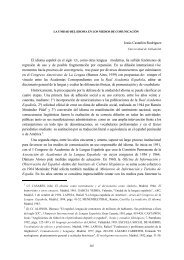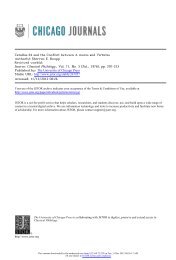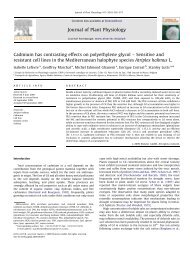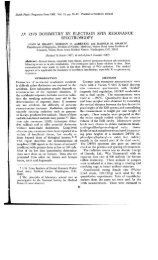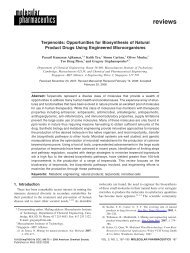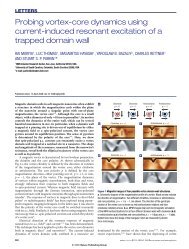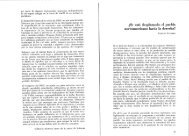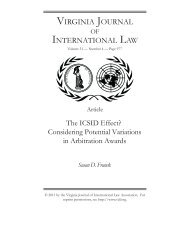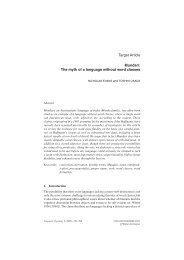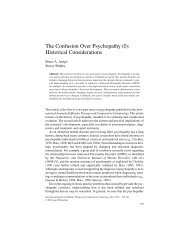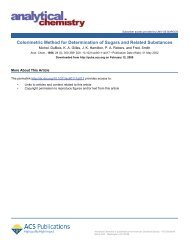Volatile composition of oak and chestnut woods used in brandy ...
Volatile composition of oak and chestnut woods used in brandy ...
Volatile composition of oak and chestnut woods used in brandy ...
Create successful ePaper yourself
Turn your PDF publications into a flip-book with our unique Google optimized e-Paper software.
Fournier, & Puech, 1995; Miller, Howell, Michaelis, &<br />
Dickman, 1992; Mosedale & Savill, 1996; Nabeta,<br />
Yonekubo, & MiYake, 1986; Sefton, Francis, Pocock,<br />
& Williams, 1993), the season<strong>in</strong>g <strong>of</strong> the staves (Chatonnet,<br />
1995; Sefton et al., 1993) <strong>and</strong> the toast<strong>in</strong>g <strong>of</strong> the<br />
barrel (Artajona, 1991; Canas, 2003; Chatonnet, 1995;<br />
Chatonnet, Boidron, & Pons, 1989; Dubois, 1989;<br />
Maga, 1985; Nishimura, Onishi, Masuda, Koga, &<br />
Matsuyama, 1983; Nomdedeu et al., 1988; Sarni, Moutounet,<br />
Puech, & Rabier, 1990).<br />
In spite <strong>of</strong> a substantial knowledge about volatile<br />
<strong>composition</strong> <strong>of</strong> French <strong>and</strong> American <strong>oak</strong> wood, few<br />
data are available for others <strong>woods</strong>, namely <strong>chestnut</strong><br />
<strong>and</strong> <strong>oak</strong> Portuguese <strong>woods</strong> (Borralho, 1994; Clímaco &<br />
Borralho, 1996) <strong>and</strong> from a cooperage po<strong>in</strong>t <strong>of</strong> view<br />
the first <strong>chestnut</strong> wood results were presented <strong>in</strong> preced<strong>in</strong>g<br />
works (Canas, Le<strong>and</strong>ro, Spranger, & Belchior, 1998,<br />
1999). In our previous work, it was found that the br<strong>and</strong>ies<br />
aged from <strong>chestnut</strong> barrels presented a good quality<br />
(Belchior et al., 1998; Caldeira et al., 1998) <strong>and</strong> higher<br />
levels <strong>of</strong> some phenolic compounds (Canas, Caldeira,<br />
et al., 1998; Canas, Le<strong>and</strong>ro, Spranger, & Belchior,<br />
1999).<br />
The aim <strong>of</strong> this study is to characterise Portuguese<br />
<strong>chestnut</strong> <strong>and</strong> <strong>oak</strong> wood comparatively with French<br />
<strong>and</strong> American <strong>oak</strong> wood, us<strong>in</strong>g volatile <strong>composition</strong><br />
<strong>and</strong> also to po<strong>in</strong>t out the modifications <strong>in</strong>duced by the<br />
heat treatment, made dur<strong>in</strong>g the cooperage process.<br />
2. Material <strong>and</strong> methods<br />
2.1. Experimental design <strong>and</strong> wood sampl<strong>in</strong>g<br />
A two factorial design (7 <strong>woods</strong> · 4 toast<strong>in</strong>g levels · 2<br />
replicates) was established <strong>and</strong> 56 wood samples were<br />
taken.<br />
The anatomical study (Carvalho, 1998) led to the<br />
botanical identification <strong>of</strong> seven wood species: three<br />
Portuguese <strong>oak</strong> wood, which were all Quercus pyrenaica<br />
Willd. from three different sites <strong>in</strong> the north <strong>of</strong> Portugal<br />
(CNE, CNF, CNG); two French <strong>oak</strong> wood, one from<br />
Allier identified as Quercus sessiliflora Sallisb. (CFA)<br />
<strong>and</strong> another from Limous<strong>in</strong> region identified as Quercus<br />
robur L. (CFL); one American <strong>oak</strong> wood which was a<br />
mixture <strong>of</strong> Quercus alba L./Quercus stellata Wangenh.<br />
<strong>and</strong> Quercus lyrata Walt./Quercus bicolor Willd.(CAM)<br />
<strong>and</strong> one Portuguese <strong>chestnut</strong> wood (CAST), from the<br />
northern, identified as Castanea sativa Mill. From each<br />
wood, six barrels were constructed, which were submitted<br />
to heat treatment with 3 degrees <strong>of</strong> toast<strong>in</strong>g: light<br />
(QL), medium (QM) <strong>and</strong> strong (QF), with two replicates<br />
<strong>of</strong> each. Before <strong>and</strong> after the toast<strong>in</strong>g process <strong>of</strong><br />
the barrels, shaves were cut <strong>in</strong> order to get samples from<br />
the wood. The two replicates <strong>of</strong> each wood, taken before<br />
toast<strong>in</strong>g, represent the fist level <strong>of</strong> toast<strong>in</strong>g factor (Q0).<br />
I. Caldeira et al. / Journal <strong>of</strong> Food Eng<strong>in</strong>eer<strong>in</strong>g 76 (2006) 202–211 203<br />
The toast<strong>in</strong>g process was controlled by the cooper 1 ,<br />
which is about 10 m<strong>in</strong> (light toast<strong>in</strong>g), 20 m<strong>in</strong> (medium<br />
toast<strong>in</strong>g) <strong>and</strong> 25 m<strong>in</strong> (strong toast<strong>in</strong>g) <strong>of</strong> slow toast<strong>in</strong>g<br />
the barrel, over a fire <strong>of</strong> the respective wood <strong>of</strong>fcuts.<br />
2.2. Wood extraction<br />
Hydroalcoholic wood extracts were obta<strong>in</strong>ed with<br />
50 g <strong>of</strong> milled wood (Hammer-Mill–Wiley) macerated,<br />
under rotary agitation for 180 m<strong>in</strong> at 20 °C, with<br />
1000 mL <strong>of</strong> an ethanol–water solution at 55% v/v adjusted<br />
to pH 4.2 with hydrochloric acid, accord<strong>in</strong>g to<br />
conditions previously selected (Caldeira, Pereira,<br />
Clímaco, Belchior, & Bruno de Sousa, 2004).<br />
The hydroalcoholic wood extracts were filtered<br />
through a glass micr<strong>of</strong>ibre filter (Whatman GF/C) <strong>in</strong> a<br />
Büchner funnel.<br />
2.3. Wood moisture<br />
The wood powder moisture was determ<strong>in</strong>ed <strong>in</strong> a<br />
moisture analyser (Mettler LJ 16-Switzerl<strong>and</strong>).<br />
2.4. Analysis <strong>of</strong> volatile compounds<br />
The isolation <strong>of</strong> the volatile compounds, from the<br />
hydroalcoolic wood extracts, was done by liquid/liquid<br />
extraction with three successive aliquots <strong>of</strong> dichloromethane,<br />
<strong>and</strong> the analysis <strong>of</strong> the compounds by GC<br />
<strong>and</strong> GC–MS, was carried out as described by Caldeira<br />
(2004) <strong>and</strong> Caldeira et al. (2004), with some modifications<br />
on the GC conditions: each concentrated extract<br />
was <strong>in</strong>jected <strong>in</strong> a Carlo Erba 6000 Vega series equipped<br />
with a flame ionisation detector (250 °C) <strong>and</strong> with a silica<br />
capillary column (DB-WAX–J&W: 30 m-lengh,<br />
0.32 mm-<strong>in</strong>ternal diameter, 0.25 lm-film thickness); elution<br />
was carried out with hydrogen as carrier gas<br />
(1.4 mL m<strong>in</strong> 1 ); temperature program: 3.5 °C m<strong>in</strong> 1<br />
from 45 °C (5-m<strong>in</strong> isothermal) to 210 °C (30-m<strong>in</strong> isothermal);<br />
the <strong>in</strong>jector was at 250 °C, <strong>and</strong> approximately<br />
0.8 lL was <strong>in</strong>jected with a split ratio <strong>of</strong> 1:15.<br />
Quantification was carried out by the <strong>in</strong>ternal st<strong>and</strong>ard<br />
method; the response factor <strong>of</strong> volatile compounds<br />
to the <strong>in</strong>ternal st<strong>and</strong>ard was arbitrarily fixed at 1.0 <strong>and</strong><br />
the results were expressed as lg/g <strong>of</strong> dry wood.<br />
2.4.1. Reagents<br />
All solvents <strong>used</strong> were analytical grade purchased<br />
from Merck (Darmstadt, Germany) <strong>and</strong> the dichloromethane<br />
were bidistilled.<br />
2.4.2. Reference compounds<br />
Acetic acid was purchased from Riedel-de-Haen (Seelze,<br />
Germany); 2-methyl-1-butanol, 3-methyl-1-butanol,<br />
1 Tanoaria J. M. Gonçaves, Palaçoulo-Portugal.



